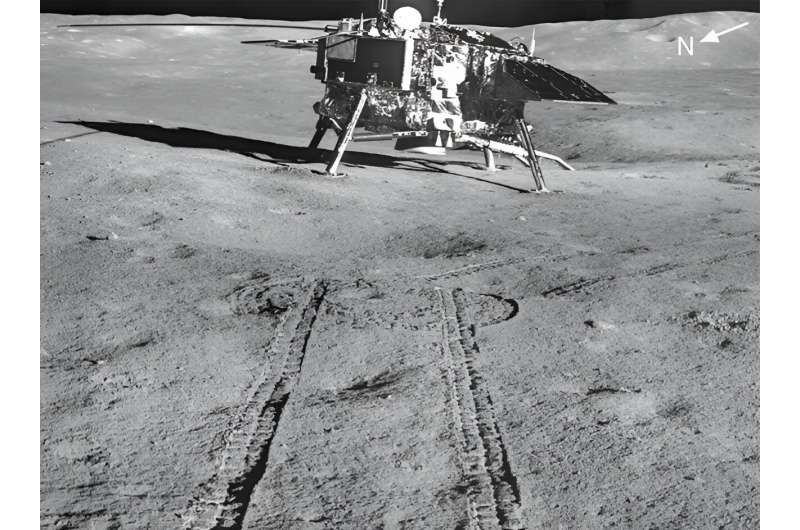
A team of space scientists at the Planetary Science Institute, working with colleagues from the Chinese Academy of Sciences, Shenzhen University and the University of Aberdeen, has used data from China's Chang'E-4 rover to learn more about the history of the moon. In their study, reported in the Journal of Geophysical Research: Planets, the group analyzed lunar-penetrating radar (LPR) data sent back from the rover.
China's Chang'E-4 rover has been wandering around on the far side of the moon since 2018. And during its meanderings, it has been sending radio signals downward using its LPR device. That same device detects and records signals that are bounced back—a form of radar. Three years ago, another team of researchers used a subset of the same data to create a subsurface map extending 40 meters below the surface. In this new paper, the research team has built on that effort, creating a subsurface map extending 300 meters below the surface.
The research team has found that the top 300 meters of the moon's surface is made up of several layers of material, some broken rock, some dust and some soil. The researchers have also found evidence of a hidden crater. Below that, they found layers of lava—evidence of the moon's volcanic past.
Prior research has suggested that the moon was formed approximately 4.5 billion years ago—it is believed that it was created when a large planet collided with the Earth, blasting a chunk of the combined planetary matter into orbit. Prior research has also suggested that some time later, a large object struck the moon, cracking its surface. That allowed some of the molten material inside to seep to the surface.
Data from Chang'E-4 bolsters that theory. In analyzing the layers of lava, they found that each succeeding layer was thinner than the prior layer, evidence of cooling and closing of fissures. Prior research has suggested that volcanic activity ceased on the moon approximately 1 billion years ago, and it is now considered geologically dead.
The researchers note that Chang'E-4 is still sending and listening to radio signals, which means there is more yet to learn.
More information: Jianqing Feng et al, Layered Structures in the Upper Several Hundred Meters of the Moon Along the Chang'E‐4 Rover's First 1,000‐m Traverse, Journal of Geophysical Research: Planets (2023). DOI: 10.1029/2022JE007714
© 2023 Science X Network
Citation: Penetrating radar aboard the Chang'E-4 rover reveals layers of the moon's history (2023, August 22) retrieved 22 August 2023 from https://phys.org/news/2023-08-penetrating-radar-aboard-change-rover.html
This document is subject to copyright. Apart from any fair dealing for the purpose of private study or research, no part may be reproduced without the written permission. The content is provided for information purposes only.
https://news.google.com/rss/articles/CBMiSGh0dHBzOi8vcGh5cy5vcmcvbmV3cy8yMDIzLTA4LXBlbmV0cmF0aW5nLXJhZGFyLWFib2FyZC1jaGFuZ2Utcm92ZXIuaHRtbNIBAA?oc=5
2023-08-22 15:30:01Z
2357452897
Tidak ada komentar:
Posting Komentar